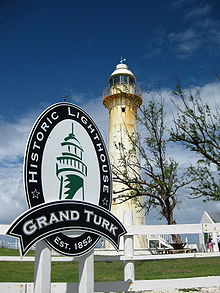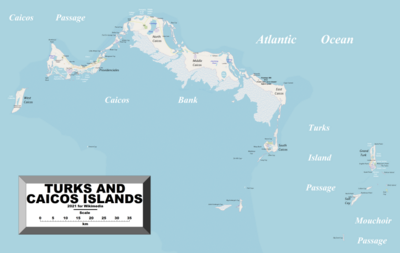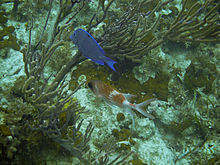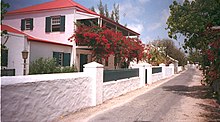
A | B | C | D | E | F | G | H | CH | I | J | K | L | M | N | O | P | Q | R | S | T | U | V | W | X | Y | Z | 0 | 1 | 2 | 3 | 4 | 5 | 6 | 7 | 8 | 9
The Turks and Caicos Islands (abbreviated TCI;[7] /ˈtɜːrks/ and /ˈkeɪkəs, -koʊs, -kɒs/) are a British Overseas Territory consisting of the larger Caicos Islands and smaller Turks Islands, two groups of tropical islands in the Lucayan Archipelago of the Atlantic Ocean and northern West Indies.[8] They are known primarily for tourism and as an offshore financial centre. The resident population in 2023 was estimated by The World Factbook at 59,367, making it the third-largest of the British overseas territories by population.[7] However, according to a Department of Statistics estimate in 2022, the population was 47,720.[9]
The islands are southeast of Mayaguana in the Bahamas island chain and north of the island of Hispaniola (Haiti and the Dominican Republic). Grand Turk (Cockburn Town), the capital since 1766, is situated on Grand Turk[2] about 1,042 kilometres (647 mi) east-southeast of Miami. They have a total land area of 430 square kilometres (170 sq mi).[a]
The islands were inhabited for centuries by Taíno people. The first recorded European sighting of them was in 1512.[12] In subsequent centuries, they were claimed by several European powers, with the British Empire eventually gaining control. For many years they were governed indirectly through Bermuda, the Bahamas, and Jamaica. When the Bahamas gained independence in 1973, the islands received their own governor, and have remained an autonomous territory since.[7]
Etymology
The name Caico is from the Lucayan caya hico, meaning 'string of islands'.[13][7] The Turks Islands are named after the Turk's cap cactus, Melocactus intortus, whose red cephalium resembles the fez hat worn by Turks in the late Ottoman Empire.[13][7]
History
Pre-colonial era
The first inhabitants of the islands were the Arawakan-speaking Taíno people, who most likely crossed over from Hispaniola some time from AD 500 to 800.[14]: 18 Together with Taíno who migrated from Cuba to the southern Bahamas around the same time, these people developed as the Lucayan.[8][15]: 80–86 Around 1200, the Turks and Caicos Islands were resettled by Classical Taínos from Hispaniola.[16]
European arrival
It is unknown precisely who the first European to sight the islands was. Some sources state that Christopher Columbus saw the islands on his voyage to the Americas in 1492.[8] However, other sources state that it is more likely that Spanish conquistador Juan Ponce de León was the first European in Turks and Caicos, in 1512.[12] In either case, by 1512 the Spanish had begun capturing the Taíno and Lucayans as labourers in the encomienda system to replace the largely depleted native population of Hispaniola.[17]: 92–99 [18]: 159–160, 191 As a result of this, and the introduction of diseases to which the native people had no immunity, the southern Bahama Islands and the Turks and Caicos Islands were completely depopulated by about 1513, and remained so until the 17th century.[19]: 34–37 [20]: 37–39 [21][page range too broad]
European settlement


From the mid-1600s Bermudian salt collectors began seasonally visiting the islands, later settling more permanently with their African slaves.[8][22] For several decades around the turn of the 18th century, the islands became popular pirate hideouts.[22] During the Anglo-French War (1778–1783) the French captured the archipelago in 1783; however, it was later confirmed as a British colony with the Treaty of Paris (1783). After the American War of Independence (1775–1783), many Loyalists fled to British Caribbean colonies, also bringing with them African slaves.[8][22] They developed cotton as an important cash crop, but it was superseded by the development of the salt industry, with the labour done by African slaves forcibly imported from Africa or the other Caribbean islands and their descendants, who soon came to outnumber the European settlers.[8]
In 1799, both the Turks and the Caicos island groups were annexed by Britain as part of the Bahamas.[8] The processing of sea salt was developed as a highly important export product from the West Indies and continued to be a major export product into the nineteenth century.
19th century
In 1807, Britain prohibited the slave trade and, in 1833, abolished slavery in its colonies.[8] British ships sometimes intercepted slave traders in the Caribbean, and some ships were wrecked off the coast of these islands. In 1837, the Esperança, a Portuguese slaver, was wrecked off East Caicos, one of the larger islands. While the crew and 220 captive Africans survived the shipwreck, 18 Africans died before the survivors were taken to Nassau. Africans from this ship may have been among the 189 liberated Africans whom the British colonists settled in the Turks and Caicos from 1833 to 1840.[23]: 211
In 1841, the Trouvadore, an illegal Spanish slave ship, was wrecked off the coast of East Caicos. All of the 20 man crew and 192 captive Africans survived the sinking. Officials freed the Africans and arranged for 168 persons to be apprenticed to island proprietors on Grand Turk for one year. They increased the small population of the colony by seven per cent.[23]: 212 The remaining 24 were resettled in Nassau, Bahamas. The Spanish crew were also taken there, to be turned over to the custody of the Cuban consul and taken to Cuba for prosecution.[24] An 1878 letter documents the "Trouvadore Africans" and their descendants as constituting an essential part of the "labouring population" on the islands.[23]: 210 In 2004, marine archaeologists affiliated with the Turks and Caicos National Museum discovered a wreck, called the "Black Rock Ship", that subsequent research has suggested may be that of the Trouvadore. In November 2008, a cooperative marine archaeology expedition, funded by the United States National Oceanographic and Atmospheric Administration, confirmed that the wreck has artifacts whose style and date of manufacture link them to the Trouvadore.[23][24][25]
In 1848, Britain designated the Turks and Caicos as a separate colony under a council president.[8] In 1873–4, the islands were made part of the Jamaica colony;[8] in 1894, the chief colonial official was restyled commissioner. In 1917, Canadian Prime Minister Robert Borden suggested that the Turks and Caicos join Canada, but this suggestion was rejected by British Prime Minister David Lloyd George and the islands remained a dependency of Jamaica.[26]
20th and 21st centuries
On 4 July 1959 the islands were again designated as a separate colony, the last commissioner being restyled administrator. The governor of Jamaica also continued as the governor of the islands. When Jamaica was granted independence from Britain in August 1962, the Turks and Caicos Islands became a Crown colony.[8] Beginning in 1965, the governor of the Bahamas was also governor of the Turks and Caicos Islands and oversaw affairs for the islands.[7]

When the Bahamas gained independence in 1973, the Turks and Caicos received their own governor (the last administrator was restyled).[8] In 1974, Canadian New Democratic Party MP Max Saltsman proposed in his private member's bill C-249, "An Act Respecting a Proposed Association Between Canada and the Caribbean Turks and Caicos Islands" that Canada form an association with the Turks and Caicos Islands; however, it was never submitted to a vote.[27] Since August 1976, the islands have had their own government headed by a chief minister (now premier), the first of whom was J. A. G. S. McCartney. Moves towards independence in the early 1980s were stalled by the election of an anti-independence party in 1980 and since then the islands have remained British territory.[8] Local government was suspended from 1986 to 1988, following allegation of government involvement with drug trafficking which resulted in the arrest of Chief Minister Norman Saunders.[8][28]: 495–6
In 2002 the islands were re-designated a British Overseas Territory, with islanders gaining full British citizenship.[8] A new constitution was promulgated in 2006; however in 2009 Premier Michael Misick of the Progressive National Party (PNP) resigned in the face of corruption charges, and the United Kingdom took over direct control of the government.[29][8]
During this period of direct British rule, in 2010 the leaders of The Bahamas and the Turks and Caicos Islands discussed the possibility of forming a federation.[30]
A new constitution was promulgated in October 2012 and the government was returned to full local administration after the November 2012 elections.[8][31]: 56 Rufus Ewing of the PNP was elected as the new, restored, premier.[32][33]
In the 2016 elections, the PNP lost for the first time since they replaced Derek Hugh Taylor's government in 2003. The People's Democratic Movement (PDM) came to power with Sharlene Cartwright-Robinson as Premier.[34][8] She was replaced by Washington Misick after the PNP returned to power after winning the 2021 general elections.[35]
Geography and environment

The two island groups are in the North Atlantic Ocean about 160 kilometres (99 mi) north of Hispaniola and about 1,000 kilometres (620 mi) from Miami in the United States, at 21°46′48″N 71°48′00″W / 21.78000°N 71.80000°W. The territory is geographically contiguous to the Bahamas, both comprising the Lucayan Archipelago, but is politically a separate entity. The Caicos Islands are separated by the Caicos Passage from the closest Bahamian islands, Mayaguana and Great Inagua. The nearest foreign landmass from the Turks and Caicos Islands is the Bahamian island of Little Inagua, about 30 miles (48 km) from West Caicos.
The eight main islands and more than 22 smaller islands have a total land area of 616.3 square kilometres (238.0 square miles),[a] consisting primarily of low, flat limestone with extensive marshes and mangrove swamps and 332 square kilometres (128 sq mi) of beach front. The tallest peaks in the islands are Blue Hills on Providenciales and Flamingo Hill on East Caicos, both at a modest 48 m.[7] The weather is usually sunny (it is generally regarded that the islands receive 350 days of sun each year[36]) and relatively dry, but suffers frequent hurricanes.[7] The islands have limited natural fresh water resources; private cisterns collect rainwater for drinking. The primary natural resources are spiny lobster, conch, and other shellfish. Turks and Caicos contains three terrestrial ecoregions: Bahamian dry forests,[37] Bahamian pineyards, and Bahamian-Antillean mangroves.[38]
The two distinct island groups are separated by the Turks Island Passage.[8]
Turks Islands
The Turks Islands are separated from the Caicos Islands by Turks Island Passage, which is more than 2,200 m (7,200 ft) deep.[39] The islands form a chain that stretches north–south. The 2012 census population was 4,939 on the two main islands, the only inhabited islands of the group:
- Grand Turk (with the capital of the territory, area 17.39 km2 (6.71 sq mi),[11] population 4,831)
- Salt Cay (area 6.74 km2 (2.60 sq mi),[11] population 108)
Together with nearby islands, all on Turks Bank, those two main islands form the two administrative districts of the territory (out of six in total) that fall within the Turks Islands. Turks Bank, which is smaller than Caicos Bank, has a total area of about 324 km2 (125 sq mi).[40]: 149
The main uninhabited islands are:
Mouchoir Bank
25 kilometres (16 mi) east of the Turks Islands and separated from them by Mouchoir Passage is the Mouchoir Bank. Although it has no emergent cays or islets, some parts are very shallow and the water breaks on them. Mouchoir Bank is part of the Turks and Caicos Islands and falls within its Exclusive Economic Zone. It measures 958 square kilometres (370 sq mi) in area.[41]: 127 Two banks further east, Silver Bank and Navidad Bank, are geographically a continuation, but belong politically to the Dominican Republic.
Caicos Islands
The largest island in the Caicos archipelago is the sparsely-inhabited Middle Caicos, which measures 144 square kilometres (56 sq mi) in area, but has a population of only 168 at the 2012 Census. The most populated island is Providenciales, with 23,769 inhabitants in 2012, and an area of 122 square kilometres (47 sq mi). North Caicos (116 square kilometres (45 sq mi) in area) had 1,312 inhabitants. South Caicos (21 square kilometres (8.1 sq mi) in area) had 1,139 inhabitants, and Parrot Cay (6 square kilometres (2.3 sq mi) in area) had 131 inhabitants. East Caicos (which is administered as part of South Caicos District) is uninhabited, while the only permanent inhabitants of West Caicos (administered as part of Providenciales District) are resort staff.[42]
The Caicos Islands comprise the following main islands:
- Ambergris Cays
- Bay Cay
- Bush Cay
- Dellis Cay
- Donna Cay
- Dove Cay
- East Bay Cay
- East Caicos
- Fish Cays
- Five Cays
- Five Little Cays
- Fort George Cay
- French Cay
- Little Water Cay
- Long Cay
- Mangrove Cay
- Middle Caicos
- Middleton Cay
- North Caicos
- Parrot Cay
- Pine Cay
- Plandon Cay
- Providenciales
- Seal Cays
- Six Hill Cays
- South Caicos
- Stubbs Cay
- Water Cay
- West Caicos
- West Sand Spit
Climate
The Turks and Caicos Islands feature a tropical savannah climate (AW), with relatively consistent temperatures throughout the course of the year.[7] Summertime temperatures rarely exceed 33 °C (91 °F) and winter nighttime temperatures rarely fall below 18 °C (64 °F). Water temperature in the summer is 82 to 84 degrees (28–29 degrees celsius) and in winter about 74 to 78 degrees (23–26 degrees celsius). A constant trade wind keeps the climate at a very comfortable level.[43]
Biodiversity


The Turks and Caicos Islands are a biodiversity hotspot. The islands have many endemic species and others of international importance, due to the conditions created by the oldest established salt-pan development in the Caribbean. The variety of species includes a number of endemic species of lizards, snakes, insects and plants, and marine organisms; in addition to being an important breeding area for seabirds.[44]
The UK and Turks and Caicos Islands Governments have joint responsibility for the conservation and preservation to meet obligations under international environmental conventions.[45]
Due to this significance, the islands are on the United Kingdom's tentative list for future UNESCO World Heritage Sites.[46]
Politics

The Turks and Caicos Islands are a British Overseas Territory.[7] As a British territory, its sovereign is King Charles III of the United Kingdom, represented by a governor appointed by the monarch, on the advice of the Foreign Office.[7] With the election of the territory's first Chief Minister, J. A. G. S. McCartney, the islands first adopted a constitution on 30 August 1976. The national holiday, Constitution Day, is celebrated annually on 30 August.[47]
The territory's legal system is based on English common law, with a small number of laws adopted from Jamaica and the Bahamas. Suffrage is universal for those over 18 years of age. English is the official language. Grand Turk is the administrative and political capital of the Turks and Caicos Islands and Cockburn Town has been the seat of government since 1766.
The Turks and Caicos Islands participate in the Caribbean Development Bank, is an associate in CARICOM, a member of the Universal Postal Union and maintains an Interpol sub-bureau. The United Nations Special Committee on Decolonization includes the territory on the United Nations list of non-self-governing territories.
Under the new Constitution that came into effect in October 2012, legislative power is held by a unicameral House of Assembly, consisting of 19 seats, 15 elected and four appointed by the governor; of elected members, five are elected at large and 10 from single-member districts for four-year terms.[7]
In the 2021 elections the Progressive National Party won in a landslide and Washington Misick became Premier.[34]
Administrative divisions
The Turks and Caicos Islands are divided into six administrative districts (two in the Turks Islands and four in the Caicos Islands), headed by district commissioners. For the House of Assembly, the Turks and Caicos Islands are divided into 15 electoral districts (four in the Turks Islands and eleven in the Caicos Islands).
Judiciary
The judicial branch of government is headed by a Supreme Court; appeals are heard by the Court of Appeal and final appeals by the United Kingdom's Judicial Committee of the Privy Council.[7] There are three justices of the Supreme Court, a Chief Justice and two others. The Court of Appeal consists of a president and at least two justices of appeal.
Magistrates' Courts are the lower courts and appeals from Magistrates' Courts are sent to the Supreme Court.
As of April 2020, the Chief Justice is Justice Mabel Agyemang.[48]
List of chief justices
- 1985–1987: John Charles Rowell Fieldsend
- 1987–1990: Frederick Smith
- 1998–2004: Richard William Ground
- 2004–2007: Christopher James Ellis Gardner
- 2008–2012: Frederick Gordon Roy Ward
- 2014–2020: Margaret Ramsay-Hale
- 2020–: Mabel Maame Agyemang
Public safety
Policing is primarily the responsibility of the Royal Turks and Caicos Islands Police Force. Customs and border enforcement is the responsibility of the Border Force. At times these may be supported by the Turks and Caicos Islands Regiment.
Military and defence
This section appears to be slanted towards recent events. (November 2022) |
The defence of the Turks and Caicos Islands is the responsibility of the United Kingdom. The Royal Navy has a ship on permanent station in the Caribbean, HMS Medway, and from time-to-time may send another Royal Navy or Royal Fleet Auxiliary ship as a part of the Atlantic Patrol (NORTH) tasking. These ships' main mission in the region is to maintain British sovereignty for the overseas territories, provide humanitarian aid and disaster relief during disasters such as hurricanes, which are common in the area, and to conduct counter-narcotic operations.[7][49] In the autumn of 2022, the Royal Fleet Auxiliary RFA Tideforce, with a Wildcat helicopter embarked, was deployed to the islands to provide surveillance support to the Royal Turks and Caicos Islands Police which was confronted with rising gang violence in the territory.[50]
Turks and Caicos Islands Regiment
Governor Nigel Dakin announced in early December 2019 that the Turks and Caicos will build its own defence regiment, the Turks and Caicos Islands Regiment, with the assistance of the UK's Ministry of Defence and it is to be similar to the Royal Bermuda Regiment and the Cayman Islands Regiment. The Turks and Caicos Islands Regiment, like regiments in Bermuda and the Cayman Islands, will focus on increasing the nation's security, and, for times of natural disasters, the Regiment would be trained in engineering and communications. In mid December 2019, a team from the UK's Ministry of Defence was on Turks and Caicos to start on building the Regiment. It is projected that the Turk and Caicos Regiment will go operational sometime within the third quarter of 2020, putting it nearly half a year after the Cayman Regiment.[51]
In spring 2020, a Security and Assistance Team from the United Kingdom Ministry of Defence arrived in Turks and Caicos to assist with the COVID-19 pandemic, the 2020 Atlantic hurricane season, and to help build the new Turks and Caicos Regiment.[52]
In early June 2020, Lieutenant Colonel Ennis Grant was appointed as the commanding officer of the new Turks and Caicos Regiment.[53]
Demography
Population
| Year | Pop. | ±% |
|---|---|---|
| 1911 | 5,615 | — |
| 1921 | 5,522 | −1.7% |
| 1943 | 6,138 | +11.2% |
| 1960 | 5,668 | −7.7% |
| 1970 | 5,558 | −1.9% |
| 1980 | 7,413 | +33.4% |
| 1990 | 11,465 | +54.7% |
| 2000 | 20,014 | +74.6% |
| 2012 | 31,458 | +57.2% |
| Sources:[4][54] | ||
Eight of the thirty islands in the territory are inhabited, with a total population estimated from preliminary results of the census of 25 January 2012 (released on 12 August 2012) of 31,458 inhabitants, an increase of 58.2% from the population of 19,886 reported in the 2001 census.[4] July 2021 estimates put the population at 57,196.[7] One-third of the population is under 15 years old, and only 4% are 65 or older. In 2000 the population was growing at a rate of 3.55% per year. The infant mortality rate was 18.66 deaths per 1,000 live births and the life expectancy at birth was 73.28 years (71.15 years for males, 75.51 years for females). The total fertility rate was 3.25 children born per woman. The annual population growth rate is 2.82%.[citation needed]
The CIA World Factbook breaks down the islanders' ethnicity as African 87%, European 7.9%, Mixed 2.5.%, East Indian 1.3% and Other 0.7%.[7] There is a small Dominican and Haitian community on the islands.[7][8]



